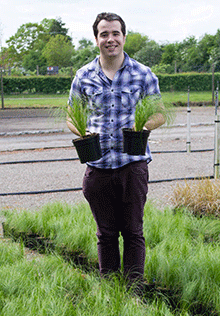One of the more democratic features of the 2015 RHS Chelsea Flower Show (which opens to the press on Monday and RHS members on Tuesday) is the Main Avenue built by the winner of BBC2’s Great Chelsea Garden Challenge
The winning amateur garden designer was revealed on screen last Thursday evening as Sean Murray, 51, an occupational therapist and nurse from Northumberland.
He was one of six would-be designers mentored by Joe Swift of BBC2's Gardeners' World for the series as they built show gardens in different styles over just four days. The series was recorded last September at gardens across including RHS Garden Harlow Carr, while the finale took place at RHS Garden Wisley.
The gardens - cottage gardens, formal gardens and conceptual gardens – were judged by RHS judge James Alexander Sinclair and Gold medal-winning garden designer Ann-Marie Powell.
The prize was the opportunity to create a Show Feature at Chelsea inspired by the RHS Greening Grey Britain campaign. The designers were judged on how well they met the brief, their horticultural knowledge, design skill and their garden’s sense of theatre.
 Wyevale Nurseries, appeared in the second programme (filmed at Sudeley Castle, Gloucestershire) for which they supplied the plants.
Wyevale Nurseries, appeared in the second programme (filmed at Sudeley Castle, Gloucestershire) for which they supplied the plants.
The RHS briefed Sean to design a front garden for the RHS Chelsea Flower Show, incorporating parking and plants as part of the charity’s new campaign to get Greening Grey Britain. As many of the UK’s front gardens are paved over for parking, the RHS wanted Sean to design a garden that would demonstrate how you can have space to park a car, but that it is also possible, and important, to incorporate plants within a front garden.
Sean's design incorporates gravel with naturalised planting and he has kept hard surfacing to a minimum, due to its associated impact on local flooding and rising temperatures. The ebb and flow of a water-filled crevice divides the garden, symbolising the flooding and draining of the earth. Reclaimed materials have been included to complement the slate dry stone walling and paving. Nooks and crannies are created to support nesting and overwintering habitats for wildlife. Secluded seating is situated beneath a tree canopy, while a tapestry of shrubs, perennials and scented climbers is interwoven with annuals and bulbs, providing year-round interest from leaf texture, form and changing colour.
Left: John Lawrence of Wyevale Nurseries, who supplied plants for the second programme.